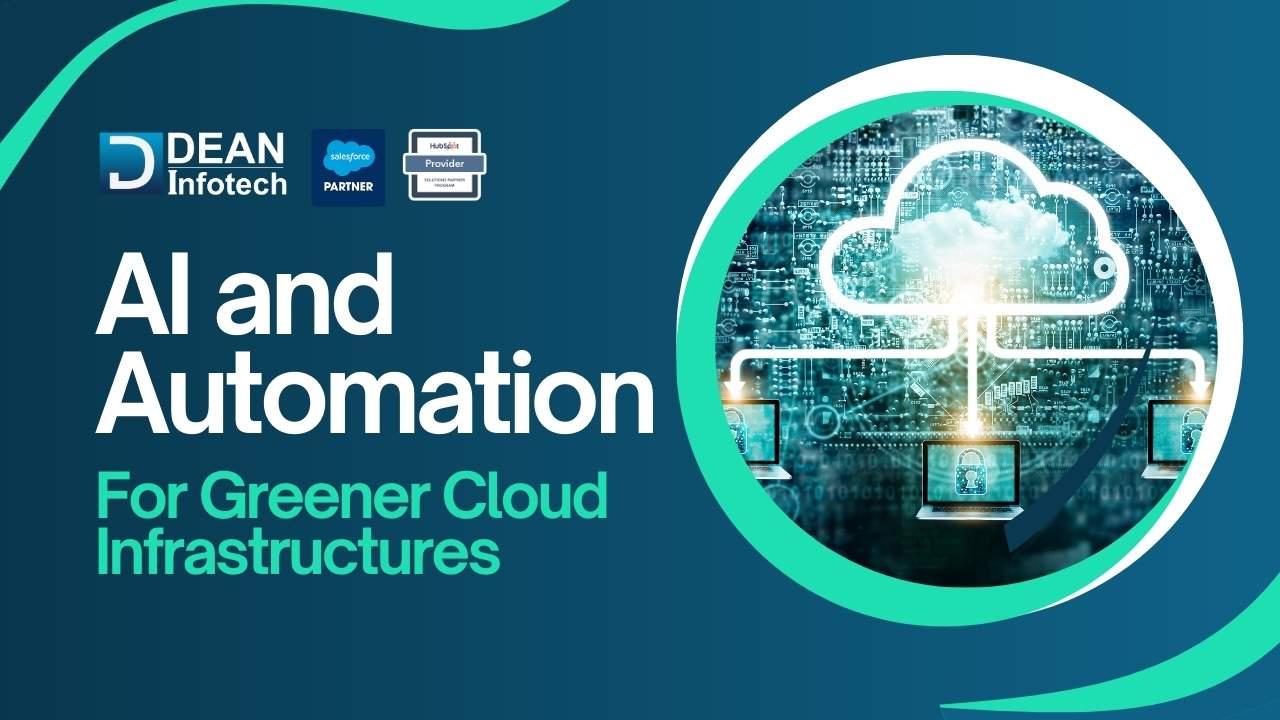The Role of AI and Automation in Creating Greener Cloud Infrastructures
 Ankit Agarwal Monday, March 24, 2025
Ankit Agarwal Monday, March 24, 2025
Cloud computing has become an integral part of modern business operations, providing scalable, flexible, and cost-effective solutions. However, this rapid growth comes with an environmental price. Data centers, the backbone of cloud infrastructure, consume vast amounts of electricity, contributing significantly to carbon emissions. With the global push towards sustainability, businesses are increasingly seeking greener alternatives.
Artificial Intelligence (AI) and automation are emerging as powerful tools to address these challenges. By optimizing energy usage, streamlining operations, and reducing waste, AI and automation are paving the way for more sustainable cloud infrastructures.
Environmental Impact of Large-Scale Data Centers
Large-scale data centers are essential for powering the digital world, from online applications to cloud storage. However, they consume a substantial amount of resources. These data centers rely heavily on electricity, contributing significantly to global carbon emissions. According to reports, data centers are responsible for about 1% of global energy consumption, with projections suggesting this could rise further as digital demands increase.
Beyond power consumption, data centers also generate significant amounts of heat. To maintain operational stability, cooling systems work tirelessly to prevent servers from overheating. This cooling process often involves air conditioning systems or water cooling technologies, both of which consume additional resources and generate further emissions.
Additionally, the lifecycle of hardware components presents another environmental challenge. Servers and other equipment have limited operational lives, leading to considerable electronic waste (e-waste). Improper disposal of outdated hardware further exacerbates pollution, adding to the growing e-waste problem.
The geographic distribution of data centers also plays a role in their carbon footprint. Centers located in regions that rely heavily on fossil fuels for electricity generation have a higher environmental impact compared to those utilizing renewable energy sources. Without strategic energy management, these facilities can become major contributors to carbon emissions.
Importance of Building Greener Cloud Infrastructures
Developing greener cloud infrastructures is no longer optional; it’s a business imperative. Governments, environmental organizations, and consumers are calling for stronger sustainability efforts. Companies that fail to reduce their carbon footprints may face regulatory fines, reputational damage, and loss of market share.
By implementing AI and automation technologies, organizations can dramatically reduce their environmental impact while maintaining operational efficiency. Greener cloud infrastructures offer numerous benefits, including:
- Reduced Carbon Footprint: AI-powered energy management systems can predict and optimize power consumption, reducing reliance on non-renewable energy sources.
- Cost Savings: Efficient resource management leads to lower energy consumption, reducing operational costs.
- Regulatory Compliance: Many governments are introducing stricter carbon emission regulations. Sustainable data centers help companies stay compliant.
- Enhanced Brand Reputation: Companies demonstrating commitment to sustainability appeal to environmentally conscious consumers and investors.
- Long-Term Resource Preservation: Sustainable practices reduce e-waste and prolong hardware lifespans, contributing to a circular economy.
Transitioning to green cloud infrastructures also presents an opportunity for companies to innovate and differentiate themselves. Cloud providers that implement AI-driven energy optimization and automated resource management can offer sustainability as a competitive advantage.
Moreover, organizations that prioritize sustainability are often seen as industry leaders. By reducing carbon emissions and promoting responsible resource use, companies contribute to global efforts in combating climate change, positioning themselves as ethical, forward-thinking enterprises.
Key Contributors to Cloud Carbon Footprints
To understand how AI and automation can reduce carbon footprints, it's essential to identify the primary sources of emissions in cloud infrastructure:
- Energy Consumption: Servers operate 24/7, requiring vast amounts of electricity for processing and storage.
- Cooling Systems: Maintaining optimal temperatures in data centers consumes significant energy.
- Over-Provisioning: Inefficient allocation of computing resources leads to unnecessary power usage.
- E-Waste: Frequent hardware upgrades result in massive amounts of electronic waste.
The Role of AI in Sustainable Cloud Management
AI has the potential to transform cloud sustainability by optimizing energy use and resource management. Here's how AI contributes to greener cloud infrastructures:
1. Energy Optimization:
- AI algorithms analyze data center operations to predict and adjust energy consumption.
- Machine learning models optimize workloads, shifting them to servers in regions with cleaner energy sources.
2. Predictive Maintenance:
- AI-powered predictive analytics detect anomalies and predict hardware failures.
- This minimizes downtime, reduces unnecessary energy consumption, and extends the life cycle of equipment.
3. Intelligent Cooling Management:
- AI systems monitor real-time data on temperature, humidity, and server workload.
- Advanced algorithms optimize cooling systems to reduce energy use while maintaining server performance.
4. Workload Management:
- AI enables dynamic workload distribution by identifying underutilized servers.
- This prevents over-provisioning and reduces overall energy consumption.
5. Renewable Energy Integration:
- AI supports data centers in integrating renewable energy sources by predicting energy demands and adjusting operations accordingly.
The Role of Automation in Sustainability
Automation complements AI in driving sustainability by streamlining repetitive tasks and enhancing operational efficiency. Key areas where automation promotes green cloud management include:
1. Resource Allocation:
- Automated systems monitor application demands and allocate resources dynamically.
- This ensures optimal server utilization, minimizing energy wastage.
2. Energy Management Systems:
- Automated energy management systems use sensors and IoT devices to regulate lighting, cooling, and server loads.
3. Carbon Footprint Tracking:
- Automation tools provide real-time insights into energy consumption and carbon emissions.
- Companies can generate accurate reports and track progress toward sustainability goals.
4. Lifecycle Management:
- Automation assists in monitoring hardware performance and predicting when equipment needs upgrades.
- Efficient e-waste management and recycling programs can be implemented using automated workflows.
5. Incident Management:
- Automated incident detection and resolution systems reduce downtime and operational inefficiencies.
- This leads to reduced energy waste during system failures.
Conclusion
AI and automation are not just technological advancements; they are essential drivers of sustainability in the cloud computing landscape. From optimizing energy consumption to enhancing resource management, these technologies enable businesses to reduce their environmental impact while maintaining operational excellence.
At Dean Infotech, we are committed to promoting sustainable digital transformation. By leveraging AI-driven insights and automated solutions, we help organizations build greener cloud infrastructures. Whether it's through intelligent workload management or carbon footprint monitoring, our solutions are designed to align with your sustainability goals.
Join us in building a smarter, greener future. Reach out to our experts to explore how we can support your cloud sustainability journey. Together, we can create a lasting impact on our planet while driving innovation and growth.








Comment